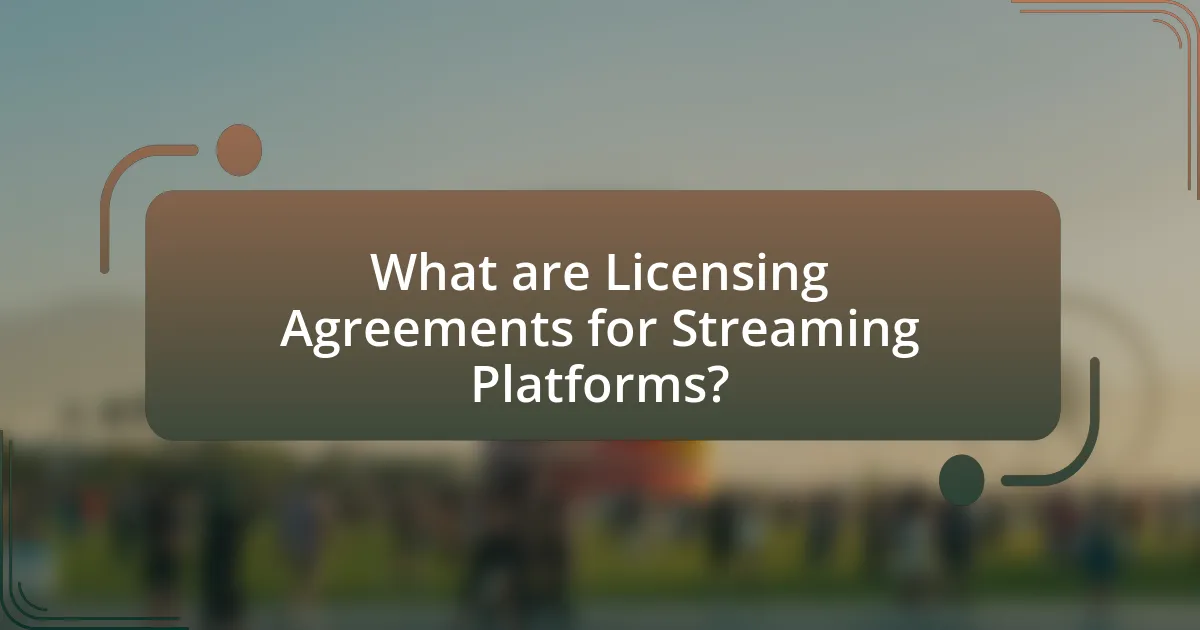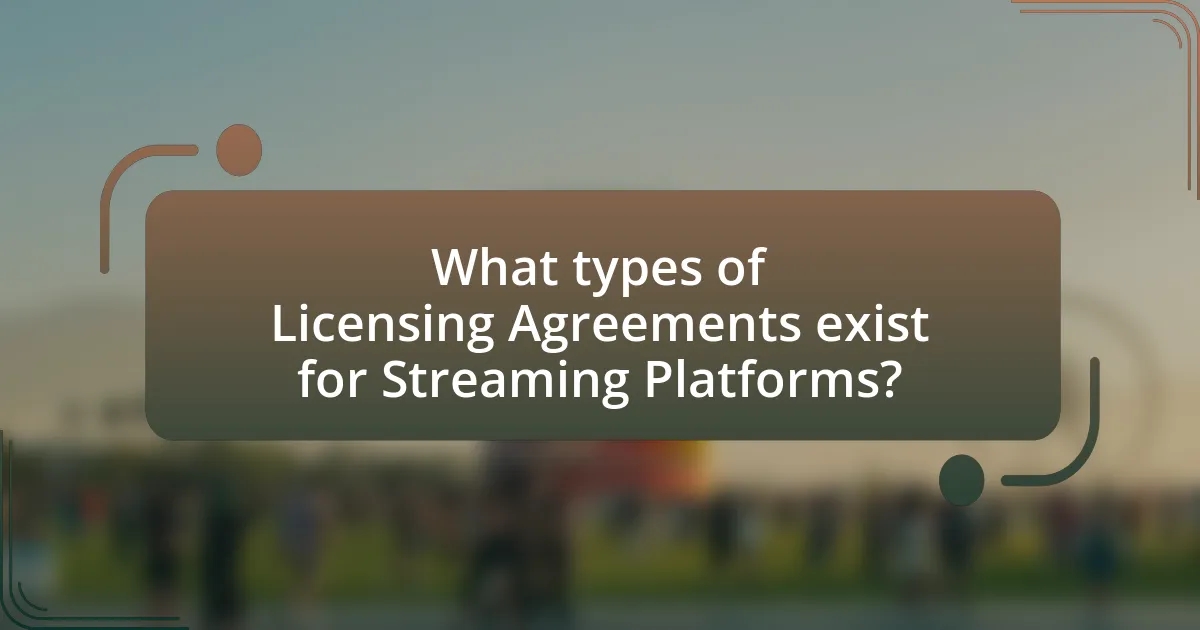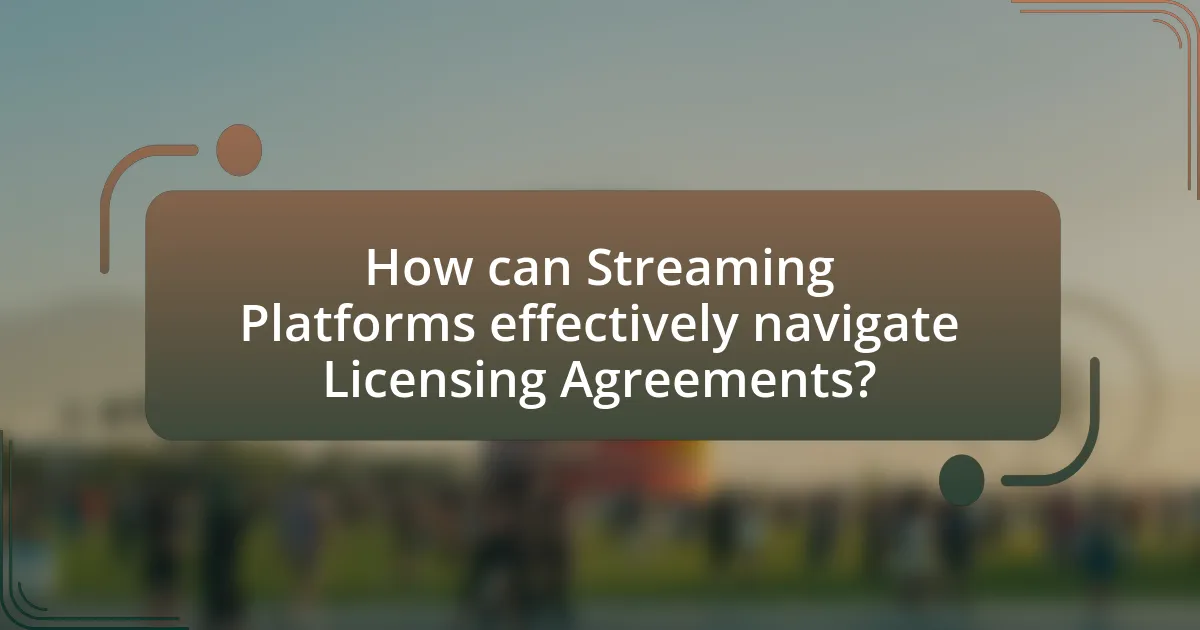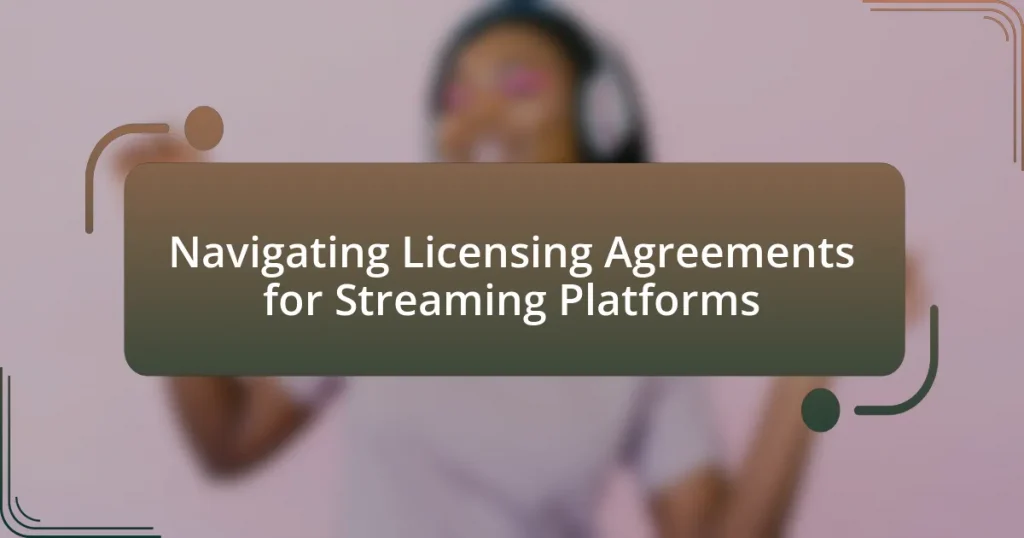Licensing agreements are essential legal contracts that grant streaming platforms the rights to distribute various types of content, including movies, TV shows, and music. This article explores the function and importance of these agreements in the streaming industry, detailing their key components, types, and the differences between exclusive and non-exclusive licenses. It also addresses the risks platforms face without proper agreements, the impact on content availability, and best practices for managing these contracts effectively. Additionally, the article highlights strategies for negotiating favorable terms and the significance of legal counsel in the process, providing a comprehensive overview of navigating licensing agreements in the competitive streaming landscape.

What are Licensing Agreements for Streaming Platforms?
Licensing agreements for streaming platforms are legal contracts that grant streaming services the rights to distribute specific content, such as movies, TV shows, or music. These agreements outline the terms under which the content can be used, including duration, geographic restrictions, and financial arrangements. For example, Netflix and Disney have licensing agreements that allow Netflix to stream certain Disney films for a specified period, demonstrating how these contracts facilitate access to popular content while ensuring that rights holders are compensated.
How do Licensing Agreements function in the streaming industry?
Licensing agreements in the streaming industry function as legal contracts that grant streaming platforms the rights to distribute specific content, such as movies, TV shows, or music. These agreements outline the terms under which the content can be used, including duration, geographic restrictions, and financial arrangements, such as royalties or flat fees. For instance, Netflix has licensing agreements with various studios that allow it to stream popular series and films, which are often exclusive to its platform for a set period. This model enables streaming services to build diverse libraries while ensuring content creators receive compensation for their work.
What are the key components of a Licensing Agreement?
The key components of a Licensing Agreement include the scope of the license, payment terms, duration of the agreement, territory, and rights granted. The scope of the license defines what is being licensed, such as specific content or technology, while payment terms outline the financial obligations, including royalties or fees. The duration specifies how long the agreement is valid, and the territory indicates where the license applies. Rights granted detail the permissions given to the licensee, such as distribution or reproduction rights. These components are essential for establishing clear expectations and legal protections for both parties involved in the agreement.
How do Licensing Agreements differ between platforms?
Licensing agreements differ between platforms primarily in terms of content ownership, distribution rights, and revenue sharing models. For instance, streaming services like Netflix often secure exclusive rights to original content, meaning they own the distribution rights and can control how and when the content is accessed. In contrast, platforms like Hulu may operate on a model that includes both licensed content from other networks and original programming, leading to different revenue-sharing arrangements with content creators. Additionally, platforms may have varying terms regarding geographic restrictions, duration of licensing, and the ability to sublicense content, which can significantly impact how content is monetized and accessed by users.
Why are Licensing Agreements important for Streaming Platforms?
Licensing agreements are crucial for streaming platforms because they legally authorize the use of copyrighted content, ensuring that platforms can offer a diverse range of movies, shows, and music. These agreements protect the intellectual property rights of content creators while enabling streaming services to build attractive libraries that attract and retain subscribers. For instance, platforms like Netflix and Hulu rely on licensing agreements to stream popular titles, which directly impacts their competitive edge in the market. Without these agreements, streaming platforms would face legal repercussions and be unable to provide the content that consumers demand, ultimately jeopardizing their business model.
What risks do Streaming Platforms face without proper Licensing Agreements?
Streaming platforms face significant legal and financial risks without proper licensing agreements, including potential copyright infringement lawsuits and hefty fines. These platforms may be subject to litigation from content owners, which can lead to costly settlements or damages. For instance, in 2019, a streaming service was sued for $100 million for unauthorized distribution of copyrighted material, highlighting the financial repercussions of inadequate licensing. Additionally, without proper agreements, platforms risk losing access to content, which can lead to decreased user engagement and subscription cancellations. This underscores the necessity of securing appropriate licenses to mitigate these risks effectively.
How do Licensing Agreements impact content availability?
Licensing agreements significantly impact content availability by determining which platforms can legally distribute specific media. These agreements outline the rights granted to streaming services, including geographic restrictions, duration of access, and exclusivity clauses. For example, a licensing agreement may allow a streaming platform to offer a film only in certain countries, limiting its availability elsewhere. Additionally, exclusive licensing can prevent competing platforms from accessing the same content, further shaping what viewers can watch. The impact of these agreements is evident in the varied content libraries across different streaming services, as each platform negotiates unique deals based on their target audience and market strategy.

What types of Licensing Agreements exist for Streaming Platforms?
Streaming platforms typically engage in three main types of licensing agreements: exclusive licenses, non-exclusive licenses, and content acquisition agreements. Exclusive licenses grant a streaming service the sole rights to distribute specific content, preventing other platforms from offering the same material. Non-exclusive licenses allow multiple platforms to stream the same content simultaneously, increasing accessibility for viewers. Content acquisition agreements involve purchasing rights to a library of content, often for a set period, enabling platforms to expand their offerings without exclusive arrangements. These licensing structures are essential for content distribution and revenue generation in the competitive streaming industry.
What are the differences between exclusive and non-exclusive licenses?
Exclusive licenses grant rights to a single licensee, preventing the licensor from granting those same rights to others, while non-exclusive licenses allow multiple licensees to use the same rights simultaneously. For example, in the context of streaming platforms, an exclusive license might mean that only one platform can stream a particular show, whereas a non-exclusive license would permit several platforms to stream the same content. This distinction impacts revenue potential and market competition, as exclusive licenses often command higher fees due to their limited availability.
How does exclusivity affect content distribution?
Exclusivity significantly impacts content distribution by limiting access to specific platforms, thereby enhancing perceived value and driving subscriber growth. When a streaming service secures exclusive rights to a popular show or movie, it creates a competitive advantage, attracting viewers who want access to that content. For instance, Netflix’s exclusive deal for “Stranger Things” contributed to a substantial increase in subscriptions, with the platform reporting a 15% growth in subscribers during the show’s release period. This exclusivity not only boosts immediate viewership but also fosters long-term loyalty, as consumers are more likely to remain subscribed to access exclusive content.
What are the implications of non-exclusive agreements for content creators?
Non-exclusive agreements allow content creators to distribute their work across multiple platforms, increasing their visibility and potential revenue streams. This flexibility enables creators to reach diverse audiences and negotiate better terms with various distributors. For instance, a study by the International Journal of Creative Industries found that creators with non-exclusive rights reported a 30% increase in overall earnings compared to those bound by exclusivity. Additionally, non-exclusive agreements can foster collaboration opportunities, as creators are not restricted to a single platform, enhancing their creative reach and influence in the industry.
What are the common terms included in Licensing Agreements?
Common terms included in Licensing Agreements for streaming platforms typically encompass grant of rights, duration, territory, payment structure, and termination clauses. The grant of rights specifies what content is licensed and the extent of usage rights, while the duration defines the time period for which the agreement is valid. Territory outlines the geographical areas where the content can be distributed. Payment structure details the financial arrangements, including royalties or flat fees, and termination clauses establish the conditions under which the agreement can be ended. These elements are essential for clarifying the responsibilities and expectations of both parties involved in the licensing process.
What is the significance of duration in Licensing Agreements?
The significance of duration in licensing agreements lies in its impact on the rights and obligations of the parties involved. Duration determines how long a licensee can use the licensed content, which affects revenue generation, market strategy, and content availability. For instance, shorter durations may lead to frequent renegotiations and potential disruptions in content access, while longer durations can provide stability and predictability for both licensors and licensees. This is particularly crucial in the fast-evolving streaming industry, where content demand and viewer preferences change rapidly. Therefore, the duration of licensing agreements is a key factor in ensuring effective content distribution and maximizing profitability for streaming platforms.
How do payment structures vary in Licensing Agreements?
Payment structures in licensing agreements vary primarily through upfront fees, royalties, and revenue-sharing models. Upfront fees involve a one-time payment made by the licensee to the licensor for the rights to use the content, which is common in exclusive agreements. Royalties are typically calculated as a percentage of revenue generated from the licensed content, incentivizing the licensor based on the content’s performance. Revenue-sharing models distribute earnings between the licensor and licensee based on predetermined terms, often seen in partnerships where both parties contribute to the content’s success. These variations reflect the negotiation dynamics and the specific goals of the involved parties, ensuring that payment structures align with the value and potential of the licensed material.

How can Streaming Platforms effectively navigate Licensing Agreements?
Streaming platforms can effectively navigate licensing agreements by conducting thorough market research and establishing clear negotiation strategies. This involves analyzing industry trends, understanding content value, and identifying key stakeholders. For instance, platforms like Netflix and Hulu have successfully negotiated exclusive content deals by leveraging data analytics to assess viewer preferences and content performance, which informs their bargaining power. Additionally, maintaining strong relationships with content creators and rights holders fosters collaboration and can lead to more favorable terms. This approach is supported by the fact that platforms that prioritize data-driven negotiations often secure higher-quality content, enhancing their competitive edge in the market.
What strategies can be employed to negotiate favorable Licensing Agreements?
To negotiate favorable licensing agreements, stakeholders should employ strategies such as thorough market research, clear value proposition articulation, and leveraging competitive offers. Conducting comprehensive market research allows negotiators to understand industry standards and pricing, which can inform their negotiation stance. Articulating a clear value proposition helps in demonstrating the unique benefits of the content or service being licensed, making it more appealing to potential partners. Additionally, leveraging competitive offers from other platforms can create leverage in negotiations, as it signals to the other party that there are alternative options available. These strategies are supported by industry practices where successful negotiations often hinge on informed decision-making and strategic positioning.
How can platforms assess the value of content in negotiations?
Platforms can assess the value of content in negotiations by analyzing audience engagement metrics, historical performance data, and market trends. Audience engagement metrics, such as viewership numbers, completion rates, and social media interactions, provide insights into how well content resonates with viewers. Historical performance data, including past licensing agreements and revenue generated from similar content, helps platforms gauge potential profitability. Additionally, market trends, such as shifts in consumer preferences and emerging genres, inform platforms about the competitive landscape and demand for specific types of content. This multifaceted approach enables platforms to make informed decisions during negotiations, ensuring they secure valuable content that aligns with their strategic goals.
What role does legal counsel play in the negotiation process?
Legal counsel plays a critical role in the negotiation process by providing expert advice on legal implications and ensuring compliance with applicable laws. Their expertise helps identify potential risks and liabilities associated with licensing agreements, which is essential for streaming platforms that must navigate complex intellectual property rights. Legal counsel also assists in drafting and reviewing contract terms to protect the interests of their clients, ensuring that agreements are clear, enforceable, and aligned with business objectives. This involvement is crucial, as improper agreements can lead to costly disputes or regulatory issues, underscoring the necessity of legal oversight in negotiations.
What are the best practices for managing Licensing Agreements?
The best practices for managing licensing agreements include thorough documentation, regular audits, clear communication, and compliance monitoring. Thorough documentation ensures that all terms, conditions, and obligations are clearly outlined, reducing the risk of misunderstandings. Regular audits help verify compliance with the agreement’s terms and identify any discrepancies early. Clear communication between parties fosters a collaborative relationship, allowing for timely resolution of issues. Compliance monitoring is essential to ensure that all parties adhere to the agreed-upon terms, which can prevent legal disputes and maintain the integrity of the licensing arrangement. These practices are supported by industry standards that emphasize the importance of transparency and accountability in licensing agreements.
How can Streaming Platforms ensure compliance with Licensing Agreements?
Streaming platforms can ensure compliance with licensing agreements by implementing robust content management systems that track usage rights and expiration dates. These systems enable platforms to monitor the terms of each agreement, ensuring that content is only available within the specified parameters. For instance, platforms like Netflix and Hulu utilize automated systems to manage their extensive libraries, which helps prevent unauthorized distribution and ensures adherence to contractual obligations. Additionally, regular audits and legal reviews of content libraries can further reinforce compliance, as evidenced by the practices of major streaming services that routinely assess their licensing agreements to mitigate risks of infringement.
What tools can assist in tracking and managing Licensing Agreements?
Tools that can assist in tracking and managing Licensing Agreements include contract management software, digital rights management (DRM) systems, and project management tools. Contract management software, such as DocuSign or ContractWorks, enables users to create, store, and track agreements efficiently, ensuring compliance and easy access to contract details. Digital rights management systems, like Adobe Experience Manager, help protect and manage the use of licensed content, providing insights into usage rights and restrictions. Project management tools, such as Trello or Asana, can facilitate collaboration among teams involved in licensing, allowing for better oversight of deadlines and deliverables related to agreements. These tools collectively enhance the efficiency and accuracy of managing licensing agreements in the streaming industry.
What common challenges do Streaming Platforms face with Licensing Agreements?
Streaming platforms commonly face challenges such as high costs, complex negotiations, and restrictive terms in licensing agreements. High costs arise from the need to secure rights for popular content, which can significantly impact profitability; for instance, Netflix reportedly spent over $17 billion on content in 2020 alone. Complex negotiations often involve multiple stakeholders, including content creators and distributors, leading to prolonged discussions that can delay content availability. Additionally, restrictive terms may limit how platforms can use or distribute content, affecting their ability to innovate or expand their offerings. These challenges necessitate careful strategic planning to balance content acquisition with financial sustainability.
How can platforms address disputes arising from Licensing Agreements?
Platforms can address disputes arising from Licensing Agreements by implementing clear dispute resolution mechanisms within the agreements themselves. These mechanisms often include mediation and arbitration clauses, which provide structured processes for resolving conflicts without resorting to litigation. For instance, the American Arbitration Association offers guidelines that many platforms adopt to facilitate efficient resolution of disputes, ensuring that both parties can reach a fair outcome while minimizing costs and time. Additionally, platforms can establish dedicated legal teams to handle disputes promptly, thereby reducing the potential for escalation and fostering better relationships with content providers.
What are the consequences of breaching a Licensing Agreement?
Breaching a Licensing Agreement can lead to significant legal and financial consequences. The licensor may pursue legal action for damages, which can include lost profits and costs incurred due to the breach. Additionally, the breaching party may face termination of the agreement, resulting in the loss of rights to use the licensed material. Courts may also impose injunctions to prevent further unauthorized use, and in some cases, punitive damages may be awarded if the breach is found to be willful. These consequences underscore the importance of adhering to the terms outlined in Licensing Agreements.
What practical tips can help Streaming Platforms succeed with Licensing Agreements?
Streaming platforms can succeed with licensing agreements by prioritizing clear communication and establishing strong relationships with content providers. Effective negotiation strategies, such as understanding market rates and being flexible with terms, can lead to mutually beneficial agreements. Additionally, conducting thorough market research to identify trending content and audience preferences allows platforms to secure valuable licenses that attract subscribers. Data from the Motion Picture Association indicates that platforms with diverse content libraries see higher user engagement, reinforcing the importance of strategic licensing.
